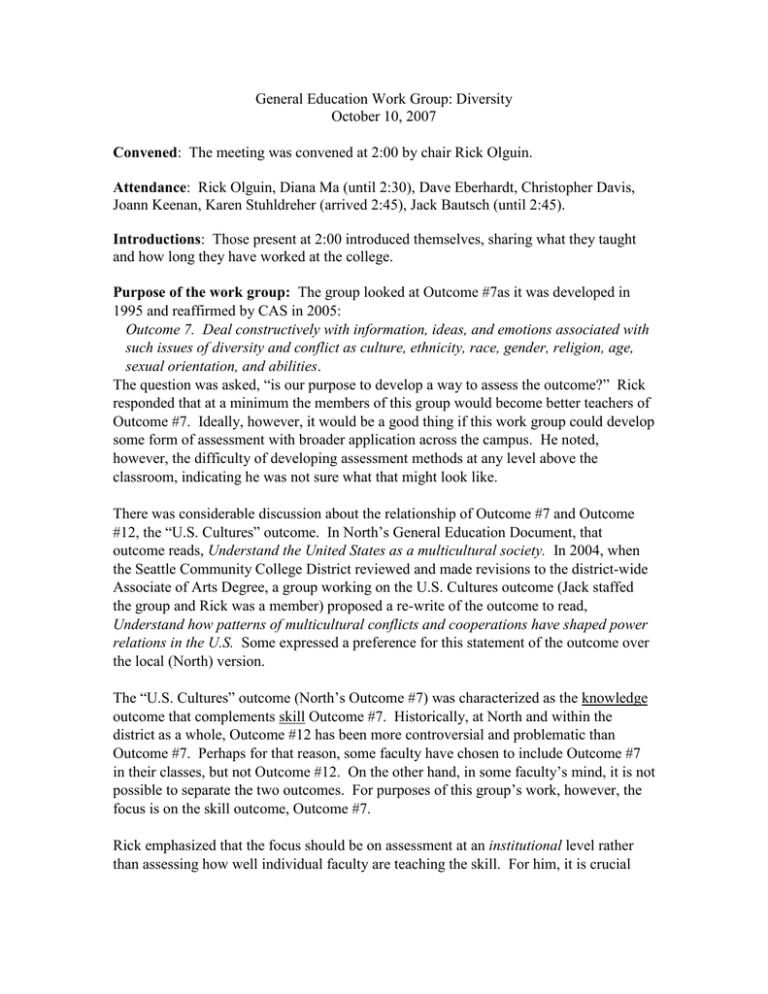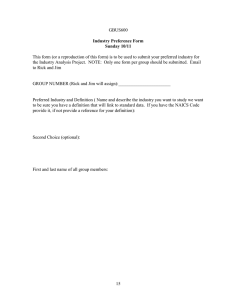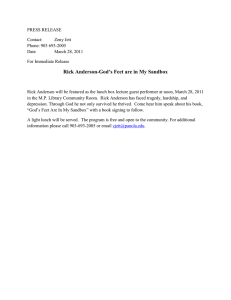General Education Work Group: Diversity October 10, 2007
advertisement

General Education Work Group: Diversity October 10, 2007 Convened: The meeting was convened at 2:00 by chair Rick Olguin. Attendance: Rick Olguin, Diana Ma (until 2:30), Dave Eberhardt, Christopher Davis, Joann Keenan, Karen Stuhldreher (arrived 2:45), Jack Bautsch (until 2:45). Introductions: Those present at 2:00 introduced themselves, sharing what they taught and how long they have worked at the college. Purpose of the work group: The group looked at Outcome #7as it was developed in 1995 and reaffirmed by CAS in 2005: Outcome 7. Deal constructively with information, ideas, and emotions associated with such issues of diversity and conflict as culture, ethnicity, race, gender, religion, age, sexual orientation, and abilities. The question was asked, “is our purpose to develop a way to assess the outcome?” Rick responded that at a minimum the members of this group would become better teachers of Outcome #7. Ideally, however, it would be a good thing if this work group could develop some form of assessment with broader application across the campus. He noted, however, the difficulty of developing assessment methods at any level above the classroom, indicating he was not sure what that might look like. There was considerable discussion about the relationship of Outcome #7 and Outcome #12, the “U.S. Cultures” outcome. In North’s General Education Document, that outcome reads, Understand the United States as a multicultural society. In 2004, when the Seattle Community College District reviewed and made revisions to the district-wide Associate of Arts Degree, a group working on the U.S. Cultures outcome (Jack staffed the group and Rick was a member) proposed a re-write of the outcome to read, Understand how patterns of multicultural conflicts and cooperations have shaped power relations in the U.S. Some expressed a preference for this statement of the outcome over the local (North) version. The “U.S. Cultures” outcome (North’s Outcome #7) was characterized as the knowledge outcome that complements skill Outcome #7. Historically, at North and within the district as a whole, Outcome #12 has been more controversial and problematic than Outcome #7. Perhaps for that reason, some faculty have chosen to include Outcome #7 in their classes, but not Outcome #12. On the other hand, in some faculty’s mind, it is not possible to separate the two outcomes. For purposes of this group’s work, however, the focus is on the skill outcome, Outcome #7. Rick emphasized that the focus should be on assessment at an institutional level rather than assessing how well individual faculty are teaching the skill. For him, it is crucial that these assessment efforts not be a way to evaluate individual faculty. In a climate of retrenchment, there is likely to be heightened fear and concern about this possibility. Rick shared the concept of “scaffolding” that was discussed when North’s General Education Task Force attended AAC&U’s General Education Institute in Newport, RI, in May 2007. Using this approach, we might identify courses in which the diversity skill is introduced, reinforced, or applied. This (or similar) framework acknowledges that the outcome may be treated in greater depth in some classes than others, or taken to more sophisticated levels in advanced courses compared to introductory courses. Jack offered that during its time at the institute, the General Education Task Force decided that this year should be spend studying the outcome to “get a lay of the land” of what is being done—by faculty in courses across the curriculum—to teach and assess the outcome. This process could also involve sharing best practices, collecting examples of assignments and/or rubrics, and developing recommendations for teaching/assessing the outcome. In his mind, what peer accreditors are looking for at North and other institutions are the presence of systematic processes for assessing how well the college is teaching the outcomes it has embraced, and for making changes where assessment data suggests they are needed. This is what Jack characterized as a “culture of assessment.” The group discussed how Outcome #7 could be effectively taught without introducing conflict into the classroom. Joann described how she does this through examples and scenarios. Rick does it through a personal style that challenges students’ thinking. He cited an example of how conflict might be present but not visible in a classroom. The example involved a student of color who reported that his teacher was afraid of him such that the teacher stopped challenging the student to higher levels of learning. Dave described a video that he uses in class that could uncover such hidden conflicts. The group talked about the possibility of viewing the video together. In terms of how the work group should begin its work, these decisions were made: Jack will provide the group with a list of the courses whose Master Course Outlines list Outcome #7. He will also provide a list of which of these courses are being taught in Fall Quarter 2007 and by which faculty. Work group members will hold one-on-one “informational conversations” with these faculty, posing the question, “what do you do with respect to Outcome #7?” Ultimately the work group would like to see specific assignments that faculty make to address the outcome, but that will not be the focus of the initial conversations. A related group of courses and faculty were identified: those who address Outcome #7 even though they do not list it on the course outline or syllabus. This could be the focus of a second round of conversations. Next meeting: The next meeting will occur in approximately four weeks. Rick observed that the group may change its meeting time because several people who wanted to be part of the group had conflicts with the current meeting time. Jack will poll people to see if a more convenient time can be found. Adjourned: The meeting adjourned at 3:30. Minutes by Jack Bautsch who used an audio recording for the portion of the meeting he missed (after 2:45).

